Dr. Bardsley’s article is very well organized which I truly appreciate. In “Women’s Work Reconsidered: Gender and Wage Differentiation in Late Medieval England”, Dr. Sandra Bardsley argues “that the rate of rural women’s wages relative to men’s wages remained consistent before and after the plague.” In other words, the Black Death did not play much of a determining factor in the salaries of women of rural areas, in relationship to the pay of men of that period. She uses tables throughout her article to make her case even more clear and illustrate her evidence to her audience.
She has a sizable section within the article, which is titled “Historiography of Women’s Wages”, within which; she holds a discourse with a large number of scholars and different perspectives within the field. The first scholar that she holds an open discussion with is James E. Thorold Rogers, with whom she disagrees because he is stating the opposite of her thesis. He is saying that the wages of women actually grew, as opposed to staying consistent. Another author is Lord Beveridge whose complete work was cut short due limitations originally and eventually to his passing.
The third author she mentions is R.H. Hilton who does not quite cover the scope that she is putting forward. She then references Simon A. C. Penn and his work in 1987. She mentions a new model that Penn put forward that helped to essentially modernize the field. The final two authors mentioned in the historiography section are Caroline M. Barron and P. J. P. Goldberg who both argue that women enjoyed higher wages after the Black Death. Even though this argument makes sense, Bardsley disagrees with these points. She agrees more with Judith M. Bennett, who has a similar perspective.
In a reply to Dr. Bardsley’s article and argument, John Hatcher published his perspective on the field and piece. He mentions that her piece is going to continue to provide strong assistance and growth to a continuously growing field. Even though, she provides conviction with her assertions Hatcher says that the field is filled with debates because it is so, essentially, webbed up and convoluted. He questions the definition of one of the main concepts of Dr. Bardsley’s paper, which is whether the payment of women was fair or not fair, in relationship to the wages of men.
He also questions her sourcing and argues that women in the class of peasantry benefitted from an almost “economic and job boom” and received a pay that was similar and consistent with the pay of men. He references several authors, in his footnotes, as evidence throughout his debate paper. Dr. Bardsley wrote a reply to Dr. Hatcher’s piece that clarifies the scope of her argument. She agrees with him on quite a few points, however there are points of disagreement and clarification in this rebuttal. She explains her sourcing and arguments/insights more thoroughly in this reply to Dr. Hatcher.





